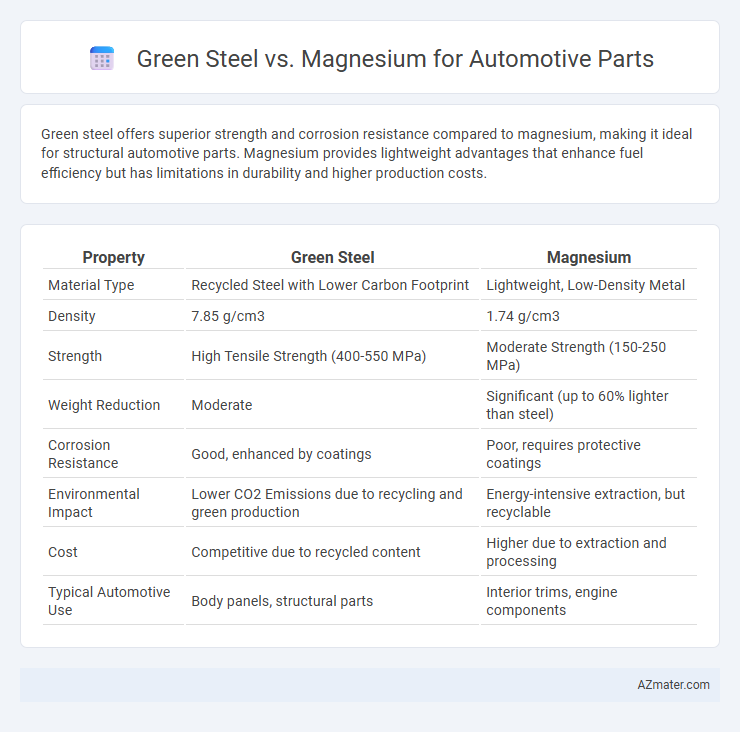Green steel offers superior strength and corrosion resistance compared to magnesium, making it ideal for structural automotive parts. Magnesium provides lightweight advantages that enhance fuel efficiency but has limitations in durability and higher production costs.
Table of Comparison
| Property | Green Steel | Magnesium |
|---|---|---|
| Material Type | Recycled Steel with Lower Carbon Footprint | Lightweight, Low-Density Metal |
| Density | 7.85 g/cm3 | 1.74 g/cm3 |
| Strength | High Tensile Strength (400-550 MPa) | Moderate Strength (150-250 MPa) |
| Weight Reduction | Moderate | Significant (up to 60% lighter than steel) |
| Corrosion Resistance | Good, enhanced by coatings | Poor, requires protective coatings |
| Environmental Impact | Lower CO2 Emissions due to recycling and green production | Energy-intensive extraction, but recyclable |
| Cost | Competitive due to recycled content | Higher due to extraction and processing |
| Typical Automotive Use | Body panels, structural parts | Interior trims, engine components |
Introduction to Green Steel and Magnesium in Automotive Manufacturing
Green steel, produced using low-carbon technologies such as hydrogen reduction or electric arc furnaces powered by renewable energy, offers automotive manufacturers a sustainable alternative to traditional steel, reducing greenhouse gas emissions significantly. Magnesium, known for its lightweight properties and high strength-to-weight ratio, contributes to improved fuel efficiency and reduced vehicle weight, making it a popular choice for structural and non-structural automotive parts. Both materials are critical in advancing eco-friendly automotive manufacturing by balancing sustainability goals with performance and safety requirements.
Environmental Impact: Green Steel vs. Magnesium
Green steel production uses hydrogen-based reduction processes that significantly lower CO2 emissions compared to traditional methods, resulting in up to 95% less carbon footprint, making it highly sustainable for automotive parts. Magnesium offers exceptional lightweighting benefits, reducing vehicle weight and therefore emissions during use, but its extraction and processing can have higher environmental impacts due to energy-intensive mining and refining. Evaluating lifecycle emissions reveals green steel as a cleaner alternative for structural components, while magnesium's environmental advantage depends heavily on sourcing and recycling efficiency.
Material Properties: Strength, Weight, and Durability
Green steel offers high tensile strength and excellent durability, making it ideal for structural automotive components requiring robustness. Magnesium stands out for its low density, being significantly lighter than green steel, which helps reduce overall vehicle weight and improve fuel efficiency. While magnesium has a favorable strength-to-weight ratio, green steel generally provides superior wear resistance and long-term durability in demanding automotive applications.
Production Processes and Sustainability
Green steel production utilizes hydrogen-based direct reduction, significantly lowering CO2 emissions compared to traditional blast furnace methods, making it a sustainable choice for automotive parts manufacturing. Magnesium parts involve extraction primarily via the Pidgeon process, which is energy-intensive and emits greenhouse gases, although recycling magnesium can reduce environmental impact. The sustainable advantage of green steel stems from renewable energy integration and reduced fossil fuel reliance, while magnesium's lightweight properties contribute to vehicle fuel efficiency but require improvements in eco-friendly production.
Cost Considerations in Automotive Applications
Green steel offers a cost advantage in automotive applications due to lower lifecycle emissions compliance costs and the potential for reduced carbon taxes compared to traditional steel. Magnesium, while lightweight and beneficial for fuel efficiency, involves higher raw material and processing expenses, impacting overall vehicle production costs. Automakers must balance the initial higher cost of magnesium with long-term savings in fuel consumption against green steel's cost-efficient sustainability benefits.
Performance in Vehicle Safety and Crashworthiness
Green steel demonstrates superior structural integrity and energy absorption in automotive safety applications, enhancing crashworthiness by effectively dissipating impact forces and minimizing cabin deformation. Magnesium alloys offer lightweight benefits, improving fuel efficiency and handling, but generally exhibit lower strength and ductility, which can compromise crash energy management compared to green steel. Optimizing vehicle safety involves balancing green steel's robustness with magnesium's weight reduction to achieve enhanced crash performance and overall occupant protection.
Recyclability and End-of-Life Benefits
Green steel offers superior recyclability in automotive parts due to its established recycling infrastructure, enabling repeated material reuse with minimal quality loss. Magnesium's lightweight properties contribute to fuel efficiency, but its recycling process is less mature, often resulting in material degradation and higher end-of-life disposal challenges. Emphasizing green steel enhances sustainability by reducing carbon footprint and promoting circular economy practices within the automotive industry.
Integration Challenges in Automotive Design
Green steel offers a sustainable alternative to traditional steel with lower carbon emissions, but its integration into automotive design faces challenges such as varying material properties and compatibility with existing manufacturing processes. Magnesium, valued for its lightweight characteristics, presents difficulties in joining techniques and corrosion resistance that complicate its widespread use in automotive parts. Both materials require advanced design adaptations and testing protocols to ensure performance, safety, and cost-effectiveness in vehicle production.
Case Studies: Automakers Using Green Steel or Magnesium
Case studies reveal automakers like Volvo and Ford increasingly use green steel to reduce carbon footprints in vehicle production, demonstrating significant emissions reductions without compromising durability. Meanwhile, BMW and Tesla integrate magnesium alloys in automotive parts to enhance lightweight design, improving fuel efficiency and vehicle performance. These real-world applications underscore the strategic shift toward sustainable materials in the automotive industry, balancing environmental impact with structural demands.
Future Outlook: Trends in Sustainable Automotive Materials
Green steel, produced using renewable energy and reduced carbon emissions, is rapidly gaining traction as a key sustainable material for automotive parts due to its strength and recyclability. Magnesium offers significant weight reduction benefits, enhancing vehicle fuel efficiency and performance, aligning with the automotive industry's push towards electrification and lower emissions. Future trends indicate increasing integration of hybrid material solutions combining green steel and magnesium to optimize sustainability, cost, and mechanical properties in next-generation vehicles.

Infographic: Green steel vs Magnesium for Automotive part
 azmater.com
azmater.com